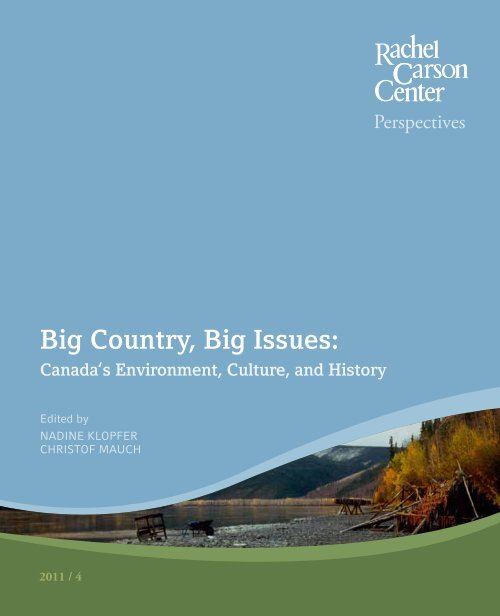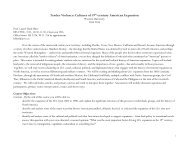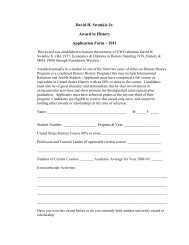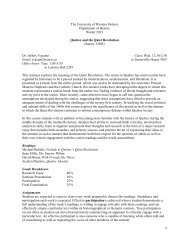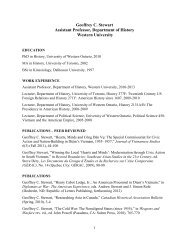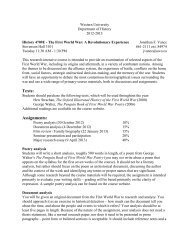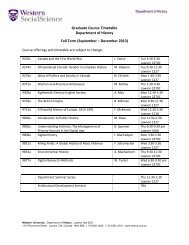A Little Essay on Big - History - University of Western Ontario
A Little Essay on Big - History - University of Western Ontario
A Little Essay on Big - History - University of Western Ontario
Create successful ePaper yourself
Turn your PDF publications into a flip-book with our unique Google optimized e-Paper software.
RCC Perspectives<strong>Big</strong> Country, <strong>Big</strong> Issues:Canada‘s Envir<strong>on</strong>ment, Culture, and <strong>History</strong>Edited byNadine Klopfer and Christ<strong>of</strong> Mauch2011 / 4
2 RCC PerspectivesC<strong>on</strong>tents04ForewordNadine Klopfer and Christ<strong>of</strong> Mauch06A <str<strong>on</strong>g>Little</str<strong>on</strong>g> <str<strong>on</strong>g>Essay</str<strong>on</strong>g> <strong>on</strong> <strong>Big</strong>: Towards a <strong>History</strong> <strong>of</strong> Canada’s SizeAlan MacEachern16Learning to Drive the Yuk<strong>on</strong> River: <strong>Western</strong> Cartography and AthapaskanStory MapsDavid Neufeld44M<strong>on</strong>treal and Its Waters: An Entangled <strong>History</strong>Michèle Dagenais60Nutriti<strong>on</strong>al Science, Health, and Changing Northern Envir<strong>on</strong>mentsLiza Piper86A Lake <strong>of</strong> Opportunity: Rethinking Phosphorus Polluti<strong>on</strong> and ResourceScarcityAndrea E. Ulrich101Pragmatism and Poetry: Nati<strong>on</strong>al Parks and the Story <strong>of</strong> CanadaClaire Elizabeth Campbell
<strong>Big</strong> Country, <strong>Big</strong> Issues3About the AuthorsClaire Elizabeth Campbell is an associate pr<strong>of</strong>essor and the coordinator <strong>of</strong> the CanadianStudies program at Dalhousie <strong>University</strong>.Michèle Dagenais is a history pr<strong>of</strong>essor at the Université de M<strong>on</strong>tréal and an expertin urban history.Nadine Klopfer is a lecturer in North American history at the Amerika-Institut <strong>of</strong> LMUMunich.Alan MacEachern teaches history at the <strong>University</strong> <strong>of</strong> <strong>Western</strong> <strong>Ontario</strong> and is thedirector <strong>of</strong> NiCHE: Network in Canadian <strong>History</strong> and Envir<strong>on</strong>ment / Nouvelle initiativecanadienne en histoire de l’envir<strong>on</strong>nement.Christ<strong>of</strong> Mauch is director <strong>of</strong> the Rachel Cars<strong>on</strong> Center for Envir<strong>on</strong>ment and Societyat LMU Munich.David Neufeld is the Yuk<strong>on</strong> and <strong>Western</strong> Arctic historian for Parks Canada.Liza Piper is an associate pr<strong>of</strong>essor <strong>of</strong> history at the <strong>University</strong> <strong>of</strong> Alberta, Canada.Andrea E. Ulrich is a researcher at the Natural and Social Science Interface (NSSI)and the Institute for Envir<strong>on</strong>mental Decisi<strong>on</strong>s at ETH Zurich.
6 RCC PerspectivesA <str<strong>on</strong>g>Little</str<strong>on</strong>g> <str<strong>on</strong>g>Essay</str<strong>on</strong>g> <strong>on</strong> <strong>Big</strong>: Towards a <strong>History</strong> <strong>of</strong> Canada’s SizeAlan MacEachernBeaver and Justin Bieber notwithstanding, Canada is best known for being big. It is thesec<strong>on</strong>d largest nati<strong>on</strong> <strong>on</strong> earth, almost ten milli<strong>on</strong> square kilometers, stretching acrosssix time z<strong>on</strong>es, eighty-eight degrees <strong>of</strong> l<strong>on</strong>gitude and forty-two degrees <strong>of</strong> latitude. Andyet despite a l<strong>on</strong>g nati<strong>on</strong>al traditi<strong>on</strong> <strong>of</strong> historical geography and a developing <strong>on</strong>e inenvir<strong>on</strong>mental history, there is no literature <strong>on</strong> Canada’s size. While there are certainlybooks that c<strong>on</strong>sider how Canadians have thought about and been shaped by the surroundingwilds, the fr<strong>on</strong>tier, or, more prevalent still, the North, I can think <strong>of</strong> not a singlehistorical work that focuses directly <strong>on</strong> Canada’s size. What have Canadians thoughtabout living in a big country? How has that size informed the nati<strong>on</strong>’s development?Perhaps our nati<strong>on</strong>’s scholars thought it bad form to draw attenti<strong>on</strong> to size. Canadacovers 6.7 percent <strong>of</strong> the Earth’s land area, yet is in the possessi<strong>on</strong> <strong>of</strong> just 34 milli<strong>on</strong>people, 0.5 percent <strong>of</strong> humanity. It is this discrepancy that makes Canadians am<strong>on</strong>gthe wealthiest people in the world. Canada c<strong>on</strong>tains a vast array <strong>of</strong> globally valuedresources, from oil to potash, from ir<strong>on</strong> ore to diam<strong>on</strong>ds. Much <strong>of</strong> Canada may bemuskeg and tundra, but its sheer size means that it also has an immense amount <strong>of</strong>farmland; <strong>on</strong>ly fourteen nati<strong>on</strong>s have more. Canada’s huge freshwater bodies helpgive its people the best water-poverty ranking <strong>on</strong> the planet and ten times the percapita water supply <strong>of</strong> the average human. In 2011, the Organizati<strong>on</strong> for Ec<strong>on</strong>omicCo-Operati<strong>on</strong> and Development ranked Canada sec<strong>on</strong>d in the world <strong>on</strong> its Better Lifeindex. 1 Canada’s great good fortune was that its borders swelled and were set duringcenturies that saw the ascensi<strong>on</strong> <strong>of</strong> the nati<strong>on</strong> state, so that it was able to establish legitimacyover this vast territory and yet saw no other nati<strong>on</strong> state fully grasp the value<strong>of</strong> such holdings or be in a positi<strong>on</strong> to appropriate them. It is perhaps not surprisingthat Canadians have made nati<strong>on</strong>al slogans <strong>of</strong> foreigners’ inability to gauge our value,such as explorer Jacques Cartier’s dismissal <strong>of</strong> Labrador (and so, in memory, <strong>of</strong> allI wish to thank Claire E. Campbell, Colin Coates, and Jeannie Prinsen for their valuable comments <strong>on</strong> a draft<strong>of</strong> this essay.1 See United Nati<strong>on</strong>s Development Programme, et al., World Resources 2008: Routes <strong>of</strong> Resilience 15 and9, http://pdf.wri.org/world_resources_2008_roots_<strong>of</strong>_resilience_tables.pdf, accessed 25 July 2011; OECDBetter Life Initiative, accessed 25 July 2011, http://www.oecdbetterlifeindex.org ; and “Pursuit <strong>of</strong> Happiness:Canada Scores High <strong>on</strong> OECD Index,” Globe and Mail, 24 May 2011.
<strong>Big</strong> Country, <strong>Big</strong> Issues7present-day Canada) as “the land God gave to Cain” or Voltaire’s quip that Canadawas but “a few acres <strong>of</strong> snow.” There is more than a hint <strong>of</strong> self-satisfacti<strong>on</strong> in our selfdeprecati<strong>on</strong>;living well is the best revenge.It may be argued that size has, in fact, been a c<strong>on</strong>stant theme, if not an outright fixati<strong>on</strong>,<strong>of</strong> Canadian scholarship and thought. Countless writers have argued that our relati<strong>on</strong>shipto the country’s vast spaces has been foundati<strong>on</strong>al to our nati<strong>on</strong>al character. NorthropFrye, for example, argued that Canadians developed a “garris<strong>on</strong> mentality” as aresult <strong>of</strong> being “c<strong>on</strong>fr<strong>on</strong>ted with a huge, unthinking, menacing, and formidable physicalsetting.” 2 Margaret Atwood identified Canadians’ informing symbol as “survival,” initiallyagainst an alien and inhospitable envir<strong>on</strong>ment and, now that the wild has beenlargely tamed, against an existential angst for which the envir<strong>on</strong>ment remains a potentmetaphor. 3 Historian J. M. S. Careless c<strong>on</strong>trasted the American fr<strong>on</strong>tier model with aCanadian <strong>on</strong>e that focused <strong>on</strong> the c<strong>on</strong>stant interc<strong>on</strong>necti<strong>on</strong> between the metropolitanand the hinterland. 4 In comparing Canadian society to the wilds bey<strong>on</strong>d, most writershave found in the difference something that paradoxically binds us together. “This alternatepenetrati<strong>on</strong> <strong>of</strong> the wilderness and return to civilizati<strong>on</strong>,” wrote historian W. L.Mort<strong>on</strong>, “is the basic rhythm <strong>of</strong> Canadian life, and forms the basic elements <strong>of</strong> Canadiancharacter.” 5But there are real cracks in such formulati<strong>on</strong>s, not least the fact that most Canadiansno l<strong>on</strong>ger experience wilderness regularly, if they ever did. Nine <strong>of</strong> our ten nati<strong>on</strong>alparks north <strong>of</strong> fifty-five degrees latitude which, because <strong>of</strong> their obligatory visitor services,are some <strong>of</strong> the most domesticated places in the northern three quarters <strong>of</strong> thenati<strong>on</strong>—had a combined attendance <strong>of</strong> less than four thousand people in 2010-11, forinstance. 6 (The point is not so much that most Canadians do not see most <strong>of</strong> Canada, itis that most <strong>of</strong> Canada is seen by hardly any<strong>on</strong>e.) More problematically, the gaze that2 Northrop Frye, “C<strong>on</strong>clusi<strong>on</strong> to A Literary <strong>History</strong> <strong>of</strong> Canada,” in The Bush Garden: <str<strong>on</strong>g>Essay</str<strong>on</strong>g>s <strong>on</strong> the CanadianImaginati<strong>on</strong> (Tor<strong>on</strong>to: House <strong>of</strong> Anansi, 1971), 225.3 Margaret Atwood, Survival: A Thematic Guide to Canadian Literature (Tor<strong>on</strong>to: House <strong>of</strong> Anansi, 2004,first published in 1972 by Anansi), esp. 40-2.4 J. M. S. Careless, “Fr<strong>on</strong>tierism, Metropolitanism, and Canadian <strong>History</strong>,” Canadian Historical Review 35,no.1 (March 1954): 1-21. This c<strong>on</strong>ceptualizati<strong>on</strong> has informed the field <strong>of</strong> urban envir<strong>on</strong>mental history, mostnotably William Cr<strong>on</strong><strong>on</strong>’s Nature’s Metropolis: Chicago and the Great West (New York: W. W. Nort<strong>on</strong>, 1991).5 W. L. Mort<strong>on</strong>, The Canadian Identity (Madis<strong>on</strong>: <strong>University</strong> <strong>of</strong> Wisc<strong>on</strong>sin Press, 1961), 5.6 The tenth, situated near the territorial capital <strong>of</strong> Whitehorse, had an attendance <strong>of</strong> almost fifty thousand.See “Attendance 2006-07 to 2010-11: Nati<strong>on</strong>al Parks, Park Reserves, & Marine C<strong>on</strong>servati<strong>on</strong> Areas,” ParksCanada, last modified 19 July 2011, accessed 25 July 2011, http://www.pc.gc.ca/eng/docs/pc/attend/table3.aspx.There are, in fact, a few other northern nati<strong>on</strong>al parks, but with no attendance listed.
8 RCC Perspectivesidentifies Canada’s vast spaces as alien while simultaneously assigning them to us ispr<strong>of</strong>oundly col<strong>on</strong>ial: not just we but the spaces also become defined as naturally andnecessarily Canadian in the process. And because the gaze looks outward to the wild,it lets us define Canada without taking into c<strong>on</strong>siderati<strong>on</strong> the land that we actuallylive <strong>on</strong>, the ground beneath our feet. Perhaps that is why so much writing about therelati<strong>on</strong>ship between nature and nati<strong>on</strong>al identity in Canada has focused <strong>on</strong> the North,a relative term that ultimately just means anywhere north <strong>of</strong> where we are. 7A map <strong>of</strong> the nati<strong>on</strong>’s ecumene, or inhabited space, serves as a useful palate cleanserwhen c<strong>on</strong>sidering Canada’s size. This suggesti<strong>on</strong> may seem counterintuitive, since theecumene solidifies the distincti<strong>on</strong> between well-populated and less-populated regi<strong>on</strong>s,but it does so in a way that moves their relati<strong>on</strong>ship bey<strong>on</strong>d simple abstracti<strong>on</strong>. Thefederal agency Statistics Canada <strong>on</strong> its maps typically ignores areas with a populati<strong>on</strong><strong>of</strong> less than 0.4 pers<strong>on</strong>s per square kilometer—much lower than the nati<strong>on</strong>al density <strong>of</strong>3.5 pers<strong>on</strong>s per square kilometer, itself <strong>on</strong>e <strong>of</strong> the lowest densities in the world—so asnot to visually skew the significance <strong>of</strong> sparsely settled areas. The resulting “ungeneralizedpopulati<strong>on</strong> ecumene” (Figure 1) presents a populated Canada that largely hugsthe American border, with <strong>on</strong>ly a northern rise into the prairie provinces and a fewpockets <strong>of</strong> “northern”—or, more accurately, south-central to central—British Columbia,Quebec, and <strong>Ontario</strong>. The map c<strong>on</strong>firms Canadians’ c<strong>on</strong>necti<strong>on</strong>s to the wilderness orto the North <strong>on</strong>ly to the degree that it suggests these places begin in our backyard andc<strong>on</strong>tinue to the Pole. The map’s obvious reminder is that the Canada <strong>of</strong> people is much,much smaller than the Canada <strong>of</strong> land: the l<strong>on</strong>g, thin ecumene is the shape <strong>of</strong> Chileand, at just over <strong>on</strong>e milli<strong>on</strong> square kilometers, about the size <strong>of</strong> Colombia. 8 A history <strong>of</strong>Canada’s size would c<strong>on</strong>template how this small, relatively localized populati<strong>on</strong> came tohave possessi<strong>on</strong> <strong>of</strong> a much larger land area, and how they came to think it natural thatthey had d<strong>on</strong>e so.What might a history <strong>of</strong> Canada’s size look like? Mine would begin before Europeanc<strong>on</strong>tact, utilizing the archaeological record to help discern the “aboriginal ecumene:”7 See, for example, Sherrill Grace, Canada and the Idea <strong>of</strong> North (M<strong>on</strong>treal: McGill-Queen’s <strong>University</strong>Press, 2001) and Renée Hulan, Northern Experience and the Myths <strong>of</strong> Canadian Culture (M<strong>on</strong>treal:McGill-Queen’s <strong>University</strong> Press, 2002). If I can get autobiographical for a moment, an old girlfriend fromTimmins (latitude: 48°) heaped c<strong>on</strong>siderable scorn <strong>on</strong> Neil Young for singing “There is a town in north<strong>Ontario</strong>” about Omemee (latitude: 44°).8 Although Colombia has its own, smaller ecumene, <strong>of</strong> course.
<strong>Big</strong> Country, <strong>Big</strong> Issues9Figure 1:“Canadian ungeneralized populati<strong>on</strong> ecumene,” adapted from Statistics Canada publicati<strong>on</strong> The Populati<strong>on</strong> Ecumene <strong>of</strong> Canada:Exploring the Past and Present, Catalogue 92F0138MIE, Issue 2008003, CensusYear 2006, No. 3, page 24, http://www.statcan.gc.ca/bsolc/olc-cel/olc-cel?catno=92F0138MIE&lang=eng.that is, which parts <strong>of</strong> present-day Canada were populated extensively by the First Nati<strong>on</strong>s,which parts occasi<strong>on</strong>ally, and which parts not at all? The point would be to openup h<strong>on</strong>est discussi<strong>on</strong> <strong>of</strong> past land use and c<strong>on</strong>cepti<strong>on</strong>s <strong>of</strong> territoriality, not in any way toquesti<strong>on</strong> or undermine present-day native claims. After all, a standard estimate puts thepopulati<strong>on</strong> <strong>of</strong> northern North America in 1500 at <strong>on</strong>e milli<strong>on</strong> <strong>of</strong> a global populati<strong>on</strong> <strong>of</strong>450 milli<strong>on</strong>, or just over 0.2 percent, whereas five centuries <strong>on</strong>, it is 34 milli<strong>on</strong> <strong>of</strong> a globalpopulati<strong>on</strong> <strong>of</strong> 7,000 milli<strong>on</strong>, or just under 0.5 percent. While this shows an increasedoccupati<strong>on</strong> <strong>of</strong> Canada since European c<strong>on</strong>tact, the rise is hardly extravagant—and itbegs the questi<strong>on</strong>, <strong>of</strong> course, as to what populati<strong>on</strong> level is required to make sovereigntylegitimate. Since Canada’s populati<strong>on</strong> is still so small in global terms, <strong>on</strong>e could arguethat we still have not reached that point today.
10 RCC PerspectivesMy history would then turn to early European c<strong>on</strong>cepti<strong>on</strong>s <strong>of</strong> Canada. It would c<strong>on</strong>siderearly maps such as Juan de la Cosa’s <strong>of</strong> circa 1500 or James Beare’s <strong>of</strong> 1578,which saw this newfound land as either just a protuberance <strong>of</strong> China or a manageableobstructi<strong>on</strong> <strong>on</strong> the way to it. It would treat the growing recogniti<strong>on</strong> by European explorers,missi<strong>on</strong>aries, settlers, and soldiers <strong>of</strong> the place’s size and what that meant tothe col<strong>on</strong>ial project. In their Relati<strong>on</strong>s, seventeenth-century Jesuits, for example, hadto somehow c<strong>on</strong>vey to their French readers what a 1,200 kilometer canoe trip fromQuebec to Hur<strong>on</strong>ia entailed. Likewise, in the early 1700s, fur trader and explorer Sieurde la Vérendrye had to overcome not <strong>on</strong>ly the physical reality <strong>of</strong> the c<strong>on</strong>tinent whensearching out a “great <strong>Western</strong> Sea” bey<strong>on</strong>d Lake Superior, and the skepticism withinthe French court that his westward trek could possibly be so l<strong>on</strong>g that it required allthe men and supplies he requested—he also had to adjust to the entirely foreign sense<strong>of</strong> space <strong>of</strong> the aboriginals he met, such as those who chose not to trade with himbecause they were c<strong>on</strong>tent to go to the English fort “<strong>on</strong>ly” twenty days’ journey away.The key series <strong>of</strong> moments in this history would be the periodic territorial expansi<strong>on</strong>sthat have occurred over the past two-and-a-half centuries, making Canada’s boundarieswhat they are today. Was there <strong>on</strong>ly a dawning general realizati<strong>on</strong> <strong>of</strong> expansi<strong>on</strong>’sgreat value, even when there were no immediate plans for the land, or were therealways a few forward-looking folks who took quiet delight as the boundaries <strong>of</strong> thispolitical jurisdicti<strong>on</strong> grew larger and larger? My history students are invariably insultedto learn that Britain, having taken Quebec in 1759, c<strong>on</strong>sidered giving it back toFrance in the ensuing peace, so as to retain Guadeloupe. But why not? New Francehad become a twenty-milli<strong>on</strong>-livre per year drain <strong>on</strong> the French ec<strong>on</strong>omy, whereasthe sugar islands accounted for half <strong>of</strong> all French imports. Size was not everything ata time when a land’s resources were valuable <strong>on</strong>ly to the degree that they could betransported efficiently, which tended to mean by water. (Even as great an explorer asSamuel Hearne, who in 1792 reached the Coppermine River and followed it to theArctic Ocean, ended his report by shrugging: “Though my discoveries are not likely toprove <strong>of</strong> any material advantage to the Nati<strong>on</strong> at large, or indeed to the Huds<strong>on</strong>’s BayCompany, yet I have the pleasure to think that I have fully complied with the orders <strong>of</strong>my Masters.”) 9 Still, tracing a history <strong>of</strong> Canada’s size would mean keeping an eye out9 Samuel Hearne, A Journey from Prince <strong>of</strong> Wales’s Fort in Huds<strong>on</strong>’s Bay to the Northern Ocean (Tor<strong>on</strong>to:The Champlain Society, 1911, first published in 1795 by A. Strathan & T. Cadell), 295.
<strong>Big</strong> Country, <strong>Big</strong> Issues11for visi<strong>on</strong>aries, those who in judging its value weighed the possibilities <strong>of</strong> riches thatmight become known or more accessible in the future.“The age <strong>of</strong> guessing is passed away,” declared surveyor David Thomps<strong>on</strong> early inthe nineteenth century, his statement simultaneously recognizing the need for a morecomprehensive geographical understanding <strong>of</strong> northern North America and indicatingthat such an understanding was well underway. 10 The Huds<strong>on</strong>’s Bay Company, inparticular, was fanning through the North and West, mapping and measuring it andin 1822 taking the first comprehensive survey <strong>of</strong> the First Nati<strong>on</strong>s who lived there.Canada’s great size—and all the barriers it imposed, all the opportunities it <strong>of</strong>fered—was becoming more firmly known. When Alexander Mackenzie became the first pers<strong>on</strong>to reach the Pacific Ocean from the Atlantic, he practically rubbed his hands inglee, proclaiming that besides the prospect <strong>of</strong> c<strong>on</strong>trolling the fur trade <strong>of</strong> the entirec<strong>on</strong>tinent, “to this might be added the fishing in both seas and the markets <strong>of</strong> the fourquarters <strong>of</strong> the globe.” 11With greater understanding and appreciati<strong>on</strong> <strong>of</strong> the size <strong>of</strong> northern North Americacame an associated insistence that its distant corners should be clearly joined to BritishNorth America and, as <strong>of</strong> 1867, to Canada. The 1840s to the 1870s saw the rapidc<strong>on</strong>solidati<strong>on</strong> and articulati<strong>on</strong> <strong>of</strong> a globally unprecedented amount <strong>of</strong> land under thec<strong>on</strong>trol <strong>of</strong> a single nati<strong>on</strong> state; that it was a new nati<strong>on</strong> with a populati<strong>on</strong> <strong>of</strong> just 3.5milli<strong>on</strong> at C<strong>on</strong>federati<strong>on</strong> makes the occurrence all the more phenomenal. These threekey decades saw the resoluti<strong>on</strong> <strong>of</strong> the internati<strong>on</strong>al boundary with the United Statesin 1846, the 1858 creati<strong>on</strong> <strong>of</strong> British Columbia as a col<strong>on</strong>y <strong>on</strong> the Pacific coast, thecreati<strong>on</strong> <strong>of</strong> Canada out <strong>of</strong> four older, eastern col<strong>on</strong>ies in 1867, the 1868 purchase <strong>of</strong>Rupert’s Land and the North-<strong>Western</strong> Territory (at over 7.7 milli<strong>on</strong> square kilometers,an area slightly larger than Australia and a spectacular acquisiti<strong>on</strong> for a <strong>on</strong>e-year-oldnati<strong>on</strong>), the integrati<strong>on</strong> <strong>of</strong> Manitoba, British Columbia, and Prince Edward Island asnew provinces in Canada’s first few years, and Canada’s acceptance <strong>of</strong> Britain’s Arcticpossessi<strong>on</strong>s in 1878 (as it would turn out, another <strong>on</strong>e milli<strong>on</strong> square kilometers—another1 percent <strong>of</strong> the globe), which were <strong>of</strong>ficially transferred two years later.10 David Thomps<strong>on</strong> quoted in David Thomps<strong>on</strong>’s Narrative 1784-1812, ed. Richard Glover (Tor<strong>on</strong>to: TheChamplain Society, 1962), 213.11 Alexander Mackenzie, Voyages from M<strong>on</strong>treal through the C<strong>on</strong>tinent <strong>of</strong> North America to the Frozen andPacific Oceans in 1789 and 1793, Vol. 2 (Tor<strong>on</strong>to: Morang, 1901), 358.
12 RCC PerspectivesThree things about what motivated Canadian c<strong>on</strong>solidati<strong>on</strong> <strong>of</strong> territory in this periodstand out. First, there was a str<strong>on</strong>g sense that size would be Canada’s quickest andlikeliest path to internati<strong>on</strong>al prominence, so there was virtue in accumulati<strong>on</strong> for thesake <strong>of</strong> accumulati<strong>on</strong>. As an <strong>Ontario</strong> politician said in 1857, it would be the taking anddeveloping <strong>of</strong> the northwest that would determine “whether this country shall ultimatelybecome a Petty State, or <strong>on</strong>e <strong>of</strong> the Great Powers <strong>of</strong> the earth.” 12 (This was rather highhanded,c<strong>on</strong>sidering “this country” was not yet a country.) Sec<strong>on</strong>d, Canadians had <strong>on</strong>lya vague idea as to what these vast real estate holdings c<strong>on</strong>tained or <strong>of</strong> what benefit theymight possibly be. And third, the land should nevertheless become Canadian if <strong>on</strong>ly sothat it would stay out <strong>of</strong> American hands. All three features are evident, for example, inthe 1878 parliamentary discussi<strong>on</strong> <strong>of</strong> whether to ask Britain to formally turn over herArctic lands <strong>on</strong>ce and for all. When an independent member spoke against the transfer<strong>on</strong> the grounds that it would force Canada to assume resp<strong>on</strong>sibility for a huge territory,the government majority <strong>of</strong>fered precious little in the way <strong>of</strong> positive reas<strong>on</strong>s why Canadamight want the land. Instead, Prime Minister John A. Macd<strong>on</strong>ald focused <strong>on</strong> thefact that Canada would look “faint-hearted” if it did not take it: “It would be unworthy <strong>of</strong>us … were we to throw away this charge.” Most critically for Macd<strong>on</strong>ald, “an Americanwas said to have boasted <strong>on</strong> the natural limits <strong>of</strong> the United States, that it was bound byCape Horn, and the Aurora Borealis; we must cut them out <strong>of</strong> that, we must extend ourterritory to that bright luminary.” 13 The moti<strong>on</strong> passed. In 1885, author Charles Tuttlewould look back <strong>on</strong> the previous decades and c<strong>on</strong>clude, “the narrow, little, rugged country<strong>on</strong> the margins <strong>of</strong> the St. Lawrence has extended its borders from Atlantic to Pacific,and to the Arctic Circle <strong>of</strong> the north. … With these changes …Canada is putting <strong>on</strong> thegarments <strong>of</strong> preparati<strong>on</strong> to enter the race <strong>of</strong> nati<strong>on</strong>s.” 14 The phrasing is instructive: Canadawas still <strong>on</strong>ly preparing to enter the race. Becoming <strong>on</strong>e <strong>of</strong> the largest nati<strong>on</strong>s <strong>of</strong>the world was, quite literally, groundwork.In the nineteenth century, the young country had shown itself to be a col<strong>on</strong>ial power,scrambling to gain territory <strong>on</strong> the far fringes <strong>of</strong> the c<strong>on</strong>tinent and using cultural, ec<strong>on</strong>omic,and political rati<strong>on</strong>ales for doing so. At the start <strong>of</strong> the twentieth century, it turnedits col<strong>on</strong>ial impulse inward, developing its territories ec<strong>on</strong>omically and, where feasible,12 Quoted in Doug Owram, Promise <strong>of</strong> Eden: The Canadian Expansi<strong>on</strong>ist Movement and the Idea <strong>of</strong> theWest, 1856-1900, vol. 2 (Tor<strong>on</strong>to: <strong>University</strong> <strong>of</strong> Tor<strong>on</strong>to Press, 1980) 49.13 See Canada, House <strong>of</strong> Comm<strong>on</strong>s, Debates, 3 May 1878, 2386-91.14 Charles Tuttle, Our North Land: Being a Full Account <strong>of</strong> the Canadian North-West and Huds<strong>on</strong>’s BayRoute… (Tor<strong>on</strong>to: C. Blackett Robins<strong>on</strong>, 1885), 18.
<strong>Big</strong> Country, <strong>Big</strong> Issues13elevating them to full provinces. When a flood <strong>of</strong> immigrati<strong>on</strong> to the prairies led to callsfor provincial status there, Prime Minister Wilfrid Laurier was compelled to articulate thedifference between a province and a territory—and, by extensi<strong>on</strong>, between the ecumeneand the rest <strong>of</strong> Canada. Noting that the territory under discussi<strong>on</strong> was as large as the sevenexisting provinces combined, Laurier stated, “I believe that when provinces are not theresult <strong>of</strong> historic traditi<strong>on</strong>, when they have not come to us formed and when we have thec<strong>on</strong>trol <strong>of</strong> events, it is preferable that the provinces should be as near as possible about thesame size. Therefore, it is impossible to suppose that this immense territory <strong>of</strong> 1,112,527[square] miles should be formed into <strong>on</strong>e single province.” 15 Of course, neither he nor anyother Canadian has ever suggested that Canada is too immense to be a single country.The Laurier government ultimately chose to create two new Prairie provinces, Alberta andSaskatchewan, which stretched all the way to 60° latitude and later to extend Manitoba’s,<strong>Ontario</strong>’s, and Quebec’s northern boundaries, too—thus giving to many <strong>of</strong> the provincesthe same benefit <strong>of</strong> a huge hinterland that the overall nati<strong>on</strong> enjoyed.With the excepti<strong>on</strong> <strong>of</strong> some Newfoundlanders, who joined C<strong>on</strong>federati<strong>on</strong> in 1949, noCanadian alive today has lived through Canada’s growing pains. The federal governmenthas had to fight over the past century to preserve nati<strong>on</strong>al sovereignty, episodically interms <strong>of</strong> Pacific and Atlantic fisheries and c<strong>on</strong>tinuously in terms <strong>of</strong> the far North—andthe Quebecois and First Nati<strong>on</strong>s have l<strong>on</strong>g reminded us that the idea <strong>of</strong> a single Canadian“nati<strong>on</strong>” is far from clear cut—but in the main Canada’s physical structure hasremained intact. More than that, our size now seems utterly natural, a given. I rememberas a child thinking how perfect it was for calendar makers that Canada had ten provincesand two territories. Every<strong>on</strong>e gets a m<strong>on</strong>th! How did other countries do it? (Theestablishment <strong>of</strong> Nunavut as a third territory in 1999 has not led to a c<strong>on</strong>stituti<strong>on</strong>al/calendrical crisis: there is usually a separate picture <strong>on</strong> the cover.) A history <strong>of</strong> Canada’ssize—besides providing a useful case study <strong>of</strong> early modern and modern attitudes towardthe unknown, toward property, and toward the structuring and cohesi<strong>on</strong> <strong>of</strong> nati<strong>on</strong>states—could simply go a small way to reminding Canadians how unusual, how lucky,and even how globally inequitable our nati<strong>on</strong>al path has been.During the 1905 parliamentary discussi<strong>on</strong> about creating new prairie provinces, PrimeMinister Laurier noted it had been said “that as the nineteenth century had beenthe century <strong>of</strong> the United States, so the twentieth century would be the century <strong>of</strong>15 Wilfrid Laurier in Canada, House <strong>of</strong> Comm<strong>on</strong>s, Debates, 21 February 1905, 1426.


